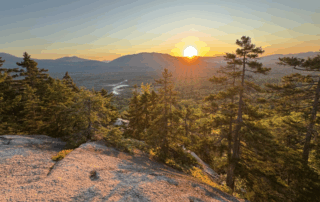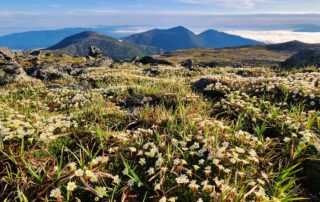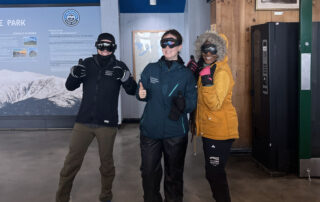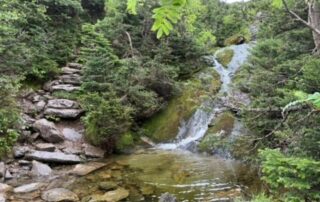Mount Washington Observatory Observer Blog
Highlights From My First Summit Summer
Highlights From My First Summit Summer By Amy Cotter While summer isn’t over yet, the month of August always feels like a wonderful bookend to my favorite season. I started with MWOBS in fall 2023 as a summit intern, followed by a year working with the MWOBS valley staff as an educator, and then moved into a Weather Observer position this past January, making this my very first summer spent on the summit. As such, summer’s end demands some reflection on my first magical, busy, and everything-in-between summer season spent at 6,288 feet. Over the past couple of months,
Trail Report: Seek the Peak Hikes 7 and 8
Trail Report: Seek the Peak Hikes 7 and 8 By Chris Nichols July 16, 2025 – Summit 7 of 17 Another opportunistic forecast, another summit! Since this was a day trip, I once again headed for the Ammonusuc Ravine Trail. The climb up to the Lakes of the Clouds hut was uneventful. About halfway up the climb past the Gem Pool is a side trail that takes you to a really cool waterfall. I hadn’t taken that side trail in years, so I thought it would be a nice change. The waterfall never disappoints, and I highly recommend the
Trail Report: Seek the Peak Hike 6
Trail Report: Seek the Peak Hike 6 By Chris Nichols July 11, 2025 – Summit 6 of 17 On my last climb, I was expecting warm temps and sunshine when I got to the summit. Today, I started in the fog, climbed in the fog, and it was foggy when I took my summit photo…then the sun came out! Since the West Side is easier to get to when I’m doing a day trip, I once again climbed the Jewel Trail. This time I went up and down Jewel, which was a first for me. That makes for a
Three Steward-Recommended 52 With a Views For Seek the Peak
Three Steward-Recommended 52 With a Views For Seek the Peak By Eric Hansen and Fawn Langerman In the early 1990s, a new hiking list was created by a group called Over the Hill Hikers, based out of Sandwich, New Hampshire. The "52 With a View" (WAV) hiking list has summits in NH that are lower elevation than 4,000’ summits, have an official trail to get there, and have a view! Over time some summits have been “delisted” as their views have grown in, and the current list has an incredible variety of hiking options in terms of location, trail
A Sneak Peek at #SeekthePeak25’s Après Hike Expo
A Sneak Peek at #SeekthePeak25's Après Hike Expo By MWOBS Staff https://youtu.be/CDyPm5kUgXc?feature=shared Whether you’re hiking with us this summer for our 25th Anniversary Seek the Peak or just want to celebrate with us, we’re less than two weeks away from our largest annual gathering at Great Glen Trails! The 2025 Seek the Peak Après Hike Expo is going to be big this year, with 475 hikers already participating in the event. If you're foregoing the fundraising hike but want to join us at the Expo, you can buy Expo tickets here ($15 per car in advance, $20 at the
Five Fun Things to Do During Seek the Peak Weekend
Five Fun Things to Do During Seek the Peak Weekend By MWOBS Staff Seek the Peak weekend is almost here, and we couldn't be more excited to bring together the amazing community that makes our work in weather and climate research possible. Even if you're not hiking or fundraising this summer for the event, we invite you to join us for a fun weekend in the Mount Washington Valley celebrating outdoor recreation, weather safety and forecasting, and the partners and supporters that make it all possible. Join us July 18 and 19 for Seek the Peak's 25th Anniversary celebration by
June 2025 By The Numbers
June 2025 By The Numbers By Ryan Knapp Diapensia in bloom in June. Photo taken 2025-06-19 by Ryan Knapp. July has arrived, so it is a perfect time to look back and summarize June 2025 and the 2024/2025 snowfall season, which ended on June 30. If I were to use adjectives to summarize June 2025's weather conditions on the summit, they would be warm, foggy, and windy. To find out why, let's look back at some of the stats for June 2025: Our average temperature for June 2025 was 47.1°F (9°C), which is 1.6°F above the 1991-2020
Team Flags Return for Seek the Peak’s 25th Anniversary
Team Flags Return for Seek the Peak's 25th Anniversary By MWOBS Staff Mount Washington Observatory is looking forward to continuing a much-loved tradition for Seek the Peak’s 25th Anniversary: Team flags. In inviting teams and individuals to create #SeekthePeak flags, we are celebrating the creativity of our participating hikers, helping spread the word on the trails, and honoring the Virtual Year of 2020, when hikers’ flags were raised on the summit at sunrise while most of us were homebound. This initiative, brought forth by former MWOBS Marketing & Communications Director Krissy Fraser, marked a symbolic community effort and has
Meet Summer Interns Zakiya, Max and Maddie
Meet Summer Interns Zakiya, Max and Maddie By MWOBS Staff We are excited to welcome six teammates to the summit of Mount Washington this summer! During their internship, these students and graduates will play a key role in supporting weather observation and data collection, engaging with the public and media and sharing weather information with visitors, and diving into a research project about mountain weather and meteorology. Below, meet three of the six team members as they reflect on their first few weeks on the summit. Zakiya Johnson Hey y'all! My name is Zakiya Johnson and I am one of the interns
Trail Report: Seek the Peak Hike 5
Trail Report: Seek the Peak Hike 5 By Chris Nichols June 23, 2025 – Summit 5 of 17 “Mountain weather is subject to rapid changes and extreme conditions…” that’s the lead sentence for the Higher Summits Forecast. Since I typically leave my house well before the morning forecast is released, I had looked at the forecast from the night before. Mainly in the clear, with temps in the low 70's and wind 25 – 35. A pretty good forecast and the possibility of experiencing a new daily high sounded like fun. One of the many water crossings.
Search with Text











